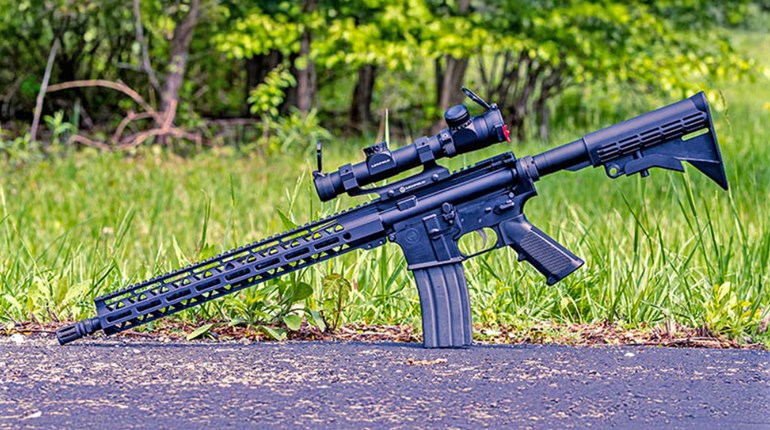
In 2011, Ruger entered the AR-15 market with its SR-556 rifle. The product made headlines, perhaps as much because of the manufacturer as the gun itself, though the SR-556 was not a run-of-the-mill AR by any means. The piston-driven 5.56 NATO rifle incorporated a quad-rail fore-end, Samson backup iron sights and a Hogue grip, plus it shipped with three, 30-round Magpul PMags. All of these desirable parts and features came at a price, however, with the SR-556 Standard retailing for just less than $2,000. Therein lay the only real criticism of the platform, since the rifle itself proved accurate, reliable and comfortable. Comfortable, that is, to everything but your wallet.

For the past several years, Ruger has implemented a “voice of the customer” program, whereby the company’s designers and engineers work with customer-service representatives to gather information about what consumers want in their firearms. This program has led to the creation of guns like the LC9, LC380 and other models that were successful from the moment they launched, largely because Ruger already knew what its customers wanted. While it probably didn’t take a whole lot of research to determine shooters would like to pay less for an excellent piston-operated AR, the SR-556E is a direct result of such customer feedback.

Built off the SR-556 design, the E model is operationally identical to the original Ruger AR. It runs via a two-stage piston, which the company claims delivers a smoother stroke to the bolt carrier. Testing the SR-556E over several days, I noticed its recoil impulse to be somewhere between a direct-gas-impingement AR and other piston-driven models I’ve shot, which would seem to verify Ruger’s claim.
Like its older sibling, the SR-556E comes with backup sights, though rather than Samson steel units, its front and rear assemblies are polymer, closely resembling Magpul’s MBUS sights. Clearly, the shift to polymer was a cost-saving move—one most shooters are unlikely to view as a negative in terms of either quality or utility. Another cost-cutter is the use of a standard AR-15 pistol grip versus the rubber Hogue Monogrip, though in this case, I definitely noticed a difference between the two SR-556 models. While there’s nothing wrong with a plain-Jane grip on an AR, a rubber grip provides enhanced comfort and purchase. The good news is swapping grips is relatively easy and inexpensive as far as AR-15 modifications go, and the omission of the Hogue grip on the SR-556E undoubtedly contributed to its lower retail price, as did the inclusion of a single Magpul PMag and a standard bolt carrier as opposed to the SR-556’s chrome-plated version.

Another cost-saving difference is the SR-556E’s gas valve, while adjustable, has only two positions—On and Off—compared with the four-position unit found on the SR-556. Again, this change is unlikely to matter to the overwhelming majority of shooters who don’t tune gas flow to any particular load. Those running a suppressor can still turn the gas off for optimal noise reduction, and everyone else probably won’t ever touch the regulator anyway.
The most striking difference between the two Ruger ARs is found in the handguards. Where the original SR-556 had a high-quality, quad-rail fore-end with indexing marks and included rail covers, the SR-556E has a thin, smooth handguard that, like its older brother, is freefloated. The savings gained here are two-fold: cost and weight. In both cases, I find the SR-556E’s handguard to be an improvement. For one thing, I am not a fan of mounting everything including the kitchen sink on the front of my ARs. While the end result may look cool, it totally throws off the balance of the rifle and makes it a pain to carry around, whether afield or in your home. A smooth fore-end is both easier to grip—particularly in the case of the thin unit found on the SR-556E—and substantially lighter. I’d wager the bulk of the 9.28-ounce weight difference between the SR-556 and the E model is a result of the different fore-ends.

These changes aside, the SR-556E is essentially identical to the SR-556, and it performed in a similar manner at the range. I have only two complaints about the platform in general: its heavy trigger and the use of a Mini-14-style flash hider as opposed to a standard A2 unit or, even better, a muzzle brake. While the Mini-14 flash hider looks fine, it adds a bit more length for no added benefit other than to help brand these ARs as Ruger rifles. Brand matters little to me—so long as the firearm functions—and it certainly doesn’t matter enough to warrant changing a perfectly functional part to one that introduces potential complications with movement purely for the sake of brand recognition. That said, it is hardly a deal-breaker.
All of the changes to the SR-556 platform that resulted in the SR-556E are intelligent and clearly influenced by customer demand for an accurate and reliable piston AR at a lower price. In that regard, Ruger shaved off more than weight from the SR-556—the SR-556E has an MSRP $620 less than its older brother. That alone makes it an excellent choice for AR buffs.






































